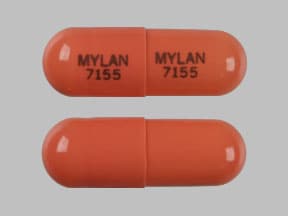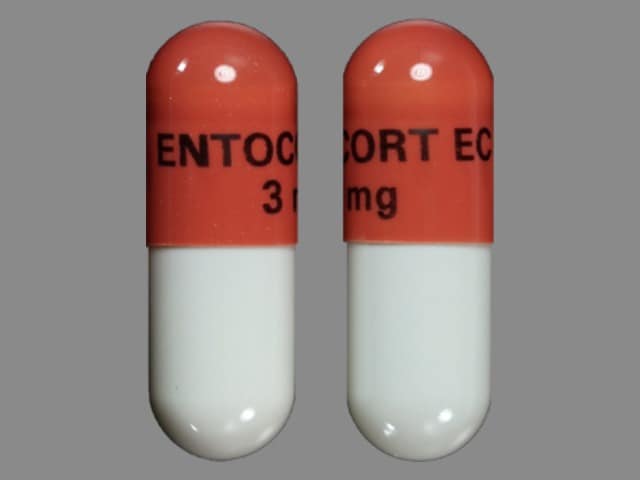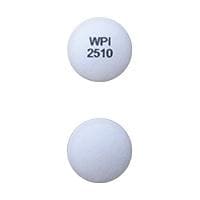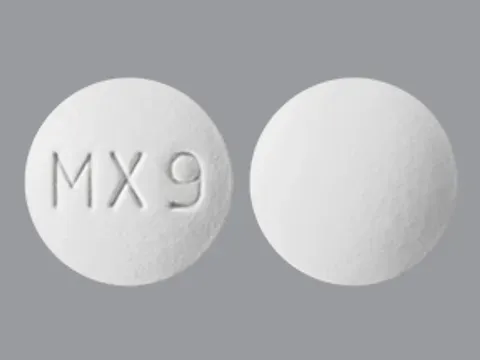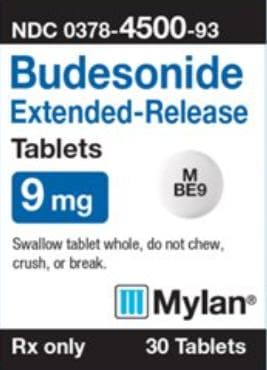Dosage Forms
Excipient information presented when available (limited, particularly for generics); consult specific product labeling.
Aerosol Powder Breath Activated, Inhalation:
Pulmicort Flexhaler: 90 mcg/actuation (1 ea); 180 mcg/actuation (1 ea) [contains milk protein]
Suspension, Inhalation:
Pulmicort: 0.25 mg/2 mL (2 mL); 0.5 mg/2 mL (2 mL); 1 mg/2 mL (2 mL) [contains disodium edta, polysorbate 80]
Generic: 0.25 mg/2 mL (2 mL); 0.5 mg/2 mL (2 mL); 1 mg/2 mL (2 mL)
Pharmacology
Mechanism of Action
Controls the rate of protein synthesis; depresses the migration of polymorphonuclear leukocytes, fibroblasts; reverses capillary permeability and lysosomal stabilization at the cellular level to prevent or control inflammation. Has potent glucocorticoid activity and weak mineralocorticoid activity.
Pharmacokinetics/Pharmacodynamics
Distribution
Children 4 to 6 years: 3 L/kg
Adults: 2.2 to 3.9 L/kg
Metabolism
Hepatic via CYP3A4 to two metabolites: 16 alpha-hydroxyprednisolone and 6 beta-hydroxybudesonide; both are <1% as active as parent
Excretion
Urine (60%) and feces as metabolites
Clearance: Children 4 to 6 years: 0.5 L/minute (~50% greater than healthy adults after weight adjustment); Adults: 0.9 to 1.8 L/minute
Onset of Action
Nebulization: 2 to 8 days; Inhalation: 24 hours
Peak effect: Nebulization: 4 to 6 weeks; Inhalation: 1 to 2 weeks
Time to Peak
Nebulization: Pulmicort Respules: Children: 20 minutes
Oral inhalation: Pulmicort Flexhaler:
Children and Adolescents: 15 to 30 minutes
Adults: 10 minutes
Half-Life Elimination
Children 4 to 6 years: 2.3 hours (after nebulization)
Children and Adolescents 10 to 14 years: 1.5 hours
Adults: 2 to 3.6 hours
Protein Binding
85% to 90%
Use in Specific Populations
Special Populations: Hepatic Function Impairment
Patients with cirrhosis had more than doubled systemic availability after oral ingestion.
Use: Labeled Indications
Asthma: Maintenance and prophylactic treatment of asthma in patients ≥6 years of age (dry powder inhaler) or 12 months to 8 years of age (nebulization suspension).
Limitations of use: Not for relief of acute bronchospasm.
Guideline recommendations: A low-dose inhaled corticosteroid (in addition to an as-needed short acting beta2-agonist) is the initial preferred long-term control medication for children, adolescents, and adult patients with persistent asthma who are candidates for treatment according to a step-wise treatment approach (GINA 2018; NAEPP 2007).
Use: Off Label
Chronic obstructive pulmonary disease (acute exacerbation)byes
Data from a multicenter, double-blind, randomized, placebo-controlled trial supports the use of budesonide in the treatment of acute exacerbations of chronic obstructive pulmonary disease (COPD). Additional trials may be necessary to further define the role of budesonide in this condition Maltais 2002.
Based on the Global Initiative for Chronic Obstructive Lung Disease (GOLD) 2018 update to the guidelines for the management of COPD, nebulized budesonide may be an alternative to oral corticosteroids for the treatment of acute exacerbations GOLD 2018.
Chronic obstructive pulmonary disease (stable)yes
Based on the Global Initiative for Chronic Obstructive Lung Disease (GOLD) 2018 update to the guidelines for the management of chronic obstructive pulmonary disease (COPD), long-term monotherapy with inhaled corticosteroids (ICS) is not recommended. Regular treatment with ICS has been shown to increase the risk of pneumonia, especially in those with severe disease. Per the 2018 GOLD guideline update, combining two long acting bronchodilators (ie, long acting beta agonist [LABA] and long acting antimuscarinic [LAMA]) is more effective in reducing exacerbations than monotherapy or the combination of ICS and LABA. If symptoms are inadequately controlled on a bronchodilator regimen, addition of an ICS may be considered. Triple inhaled therapy of ICS/LAMA/LABA has been shown to improve lung function, symptoms, and health status and reduces exacerbations compared to ICS/LABA or LAMA monotherapy GOLD 2018.
Eosinophilic esophagitisbyes
Data from controlled trials and meta-analyses indicate that inhalational budesonide, when swallowed rather than inhaled, is effective at improving the clinicopathologic features of eosinophilic esophagitis. Guidelines from the American College of Gastroenterology (ACG) and consensus recommendations from the American Gastroenterological Association (AGA)/North American Society of Pediatric Gastroenterology, Hepatology, and Nutrition (NASPGHAN) regarding diagnosis and management of eosinophilic esophagitis recommend that oral administration of inhalational corticosteroids (eg, fluticasone, budesonide) be considered as first-line therapy for eosinophilic esophagitis and that the corticosteroid type and duration of therapy be individualized. Symptoms often recur upon discontinuation, and steroid resistance has been reported.
Contraindications
Hypersensitivity to budesonide or any component of the formulation; severe hypersensitivity to milk proteins (Pulmicort Flexhaler); primary treatment of status asthmaticus or other acute episodes of asthma requiring intensive measures
Documentation of allergenic cross-reactivity for corticosteroids is limited. However, because of similarities in chemical structure and/or pharmacologic actions, the possibility of cross-sensitivity cannot be ruled out with certainty.
Canadian labeling: Additional contraindications (not in US labeling): Moderate-to-severe bronchiectasis, pulmonary tuberculosis (active or quiescent), untreated respiratory infection (bacterial, fungal, or viral)
Dosage and Administration
Dosing: Adult
Note: Titrate to lowest effective dose once asthma is stable.
Asthma: Oral inhalation: Note: To decrease the severity or duration of an asthma exacerbation, may consider temporarily quadrupling the dose (early in the course of illness) in patients with mild to moderate asthma with a mild flare in symptoms. Reserve this approach for patients with no prior history of life-threatening asthma exacerbations, and in those with good self-management skills; return to baseline dose after normalization of symptoms or at a maximum of 14 days of the quadrupled dose (Fanta 2019; GINA 2018; McKeever 2018).
Pulmicort Flexhaler: Dry powder inhaler: Initial: 360 mcg twice daily (selected patients may be initiated at 180 mcg twice daily); maximum: 720 mcg twice daily; Note: May increase dose after 1 to 2 weeks of therapy in patients who are not adequately controlled
Pulmicort Nebuamp [Canadian product]: Nebulization suspension: Initial: 1 to 2 mg twice daily; dose may be increased if needed
Pulmicort Turbuhaler [Canadian product]: Dry powder inhaler:
Initial (or during periods of severe asthma or when switching from oral corticosteroid therapy): 400 to 2,400 mcg daily in 2 to 4 divided doses
Maintenance: 200 to 400 mcg twice daily (higher doses may be needed for some patients). Patients taking 400 mcg/day may take as a single daily dose.
Asthma guidelines:
National Asthma Education and Prevention Program guidelines (NAEPP 2007): Dry powder inhaler: Note: Administer in divided doses twice daily.
Low-dose therapy: 180 to 600 mcg/day
Medium-dose therapy: >600 to 1,200 mcg/day
High-dose therapy: >1,200 mcg/day
Global Initiative for Asthma guidelines (GINA 2018): Dry powder inhaler:
Low-dose therapy: 200 to 400 mcg/day
Medium-dose therapy: >400 to 800 mcg/day
High-dose therapy: >800 mcg/day
Chronic obstructive pulmonary disease (acute exacerbation) (off-label use): Nebulization solution: 2 mg every 6 hours (Maltais 2002)
Chronic obstructive pulmonary disease (stable) (off-label use): Inhalation: 100, 200, or 400 mcg daily (dry powder inhaler) or 0.2, 0.25, or 0.5 mg/mL/day (nebulization suspension) in combination with a long-acting bronchodilator (GOLD 2014; GOLD 2018)
Eosinophilic esophagitis (off-label use): Oral: 2 mg/day as an oral budesonide viscous liquid/suspension. Dose may be divided into 2 doses. Avoid ingesting any solid or liquid food for 30 minutes after budesonide administration (Dellon 2013; Dohil 2010; Liacouras 2011; Rubinstein 2014). See Extemporaneously Prepared.
Dosing: Geriatric
Refer to adult dosing.
Dosing: Pediatric
Asthma, maintenance therapy: Note: Doses should be titrated to the lowest effective dose once asthma is controlled; dosing is presented in mg and mcg; additional precautions should be taken.
US labeling:
Pulmicort Respules: Nebulization solution: Oral inhalation:
Infants ≥6 months: Limited data available: Initial: 0.25 mg twice daily or 0.5 mg once daily; maximum daily dose: 1 mg/day (Baker 1999).
Children and Adolescents:
Symptomatic children not responding to nonsteroidal asthma medications: Initial: 0.25 mg once daily may be considered.
Previously treated with bronchodilators alone: Initial: 0.25 mg twice daily or 0.5 mg once daily; maximum daily dose: 0.5 mg/day.
Previously treated with inhaled corticosteroids: Initial: 0.25 mg twice daily or 0.5 mg once daily; maximum daily dose: 1 mg/day.
Previously treated with oral corticosteroids: Initial: 0.5 mg twice daily or 1 mg once daily; maximum daily dose: 1 mg/day.
Pulmicort Flexhaler: Dry powder inhaler: Oral inhalation:
Children ≥6 years and Adolescents <18 years: Initial: 180 mcg twice daily (some patients may be initiated at 360 mcg twice daily); maximum dose: 360 mcg/dose.
Adolescents ≥18 years: Initial: 360 mcg twice daily (some patients may be initiated at 180 mcg twice daily); maximum dose: 720 mcg/dose.
Canadian labeling:
Pulmicort Nebuamp [Canadian Product]: Nebulization solution: Oral inhalation:
Infants ≥3 months and Children: Initial: 0.25 to 0.5 mg twice daily; may increase to 1 mg twice daily.
Adolescents: Initial: 1 to 2 mg twice daily; further dose increases may be necessary.
Pulmicort Turbuhaler [Canadian product]: Dry powder inhaler: Oral inhalation:
Children 6 to 11 years: Initial (or during periods of severe asthma or when switching from oral corticosteroid therapy): 200 to 400 mcg daily in 2 divided doses; once symptoms are controlled, decrease dose to lowest effective maintenance dose.
Children ≥12 years and Adolescents:
Initial (or during periods of severe asthma or when switching from oral corticosteroid therapy): 400 to 2,400 mcg/day in 2 to 4 divided doses.
Maintenance: 200 to 400 mcg twice daily (higher doses may be needed for some patients). Note: Patients taking 400 mcg/day may take as a single daily dose.
Asthma guidelines:
Nebulization solution: Oral inhalation:
NIH Asthma Guidelines (NAEPP 2007): Administer once daily or in divided doses twice daily.
Children ≤4 years:
"Low" dose: 0.25 to 0.5 mg/day.
"Medium" dose: >0.5 to 1 mg/day.
"High" dose: >1 mg/day.
Children 5 to 11 years:
"Low" dose: 0.5 mg/day.
"Medium" dose: 1 mg/day.
"High" dose: 2 mg/day.
Global Initiative for Asthma Guidelines (GINA 2018):
Children ≤5 years:
"Low" dose: 500 mcg/day.
Children 6 to 11 years:
"Low" dose: 250 to 500 mcg/day.
"Medium" dose: >500 to 1,000 mcg/day.
"High" dose: >1,000 mcg/day.
Dry powder: Oral inhalation:
NIH Asthma Guidelines (NAEPP 2007): Administer in divided doses twice daily.
Children 5 to 11 years:
"Low" dose: 180 to 400 mcg/day.
"Medium" dose: >400 to 800 mcg/day.
"High" dose: >800 mcg/day.
Children ≥12 years and Adolescents:
"Low" dose: 180 to 600 mcg/day.
"Medium" dose: >600 to 1,200 mcg/day.
"High" dose: >1,200 mcg/day.
Global Initiative for Asthma Guidelines (GINA 2018):
Children 6 to 11 years:
"Low" dose: 100 to 200 mcg/day.
"Medium" dose: >200 to 400 mcg/day.
"High" dose: >400 mcg/day.
Children ≥12 years and Adolescents:
"Low" dose: 200 to 400 mcg/day.
"Medium" dose: >400 to 800 mcg/day.
"High" dose: >800 mcg/day.
Asthma; mild flare, exacerbation: Limited data available:
Children ≥12 years and Adolescents with mild to moderate asthma, no prior history of life-threatening asthma exacerbations, and with good self-management skills:
It is recommended to temporarily quadruple the inhaled corticosteroid dose early in the course of a mild flare to decrease the severity of an asthma exacerbation. After symptoms stabilize or after a maximum of 14 days of quadrupled dose, whichever occurs first, patients should be returned to their baseline dose (GINA 2019). Quadrupling the inhaled corticosteroid dose has been shown to decrease the severity of an asthma exacerbation in select patients. In a randomized trial of adolescents ≥16 years and adults (n=1,871), temporarily quadrupling the inhaled corticosteroid dose when asthma control began to deteriorate resulted in fewer severe asthma exacerbations (ie, less treatment with systemic glucocorticoids or unscheduled appointments for asthma) compared to patients who maintained their inhaled corticosteroid dose (McKeever 2018). No data for quadrupling the dose in patients <16 years of age has been published. Quintupling the dose of inhaled corticosteroids (fluticasone) in children 5 to 11 years of age was not shown to reduce the rate of severe exacerbations and may have been associated adverse effects (decreased linear growth, particularly in patients <8 years of age) (GINA 2019; Jackson 2018).
Extemporaneously Prepared
Oral budesonide viscous liquid/suspension: Prepare immediately prior to ingestion from aqueous budesonide solution (1 mg per 2 mL) or nebulized solution (0.5 mg per 2 mL [Pulmicort Respules]) mixed to slurry consistency with 10 packets of Splenda or 2.5 cm3 of Neocate Nutra per milligram of budesonide. (Dellon 2013; Dohil 2010; Rubinstein 2014)
Dellon ES, Gonsalves N, Hirano I, Furuta GT, Liacouras CA, Katzka DA; American College of Gastroenterology. ACG clinical guideline: Evidenced based approach to the diagnosis and management of esophageal eosinophilia and eosinophilic esophagitis (EoE). Am J Gastroenterol. 2013 May;108(5):679-92; quiz 693.23567357Dohil R, Newbury R, Fox L, Bastian J, Aceves S. Oral viscous budesonide is effective in children with eosinophilic esophagitis in a randomized, placebo-controlled trial. Gastroenterology. 2010;139(2):418-429.20457157Rubinstein E, Lee JJ, Fried A, et al. Comparison of 2 delivery vehicles for viscous budesonide to treat eosinophilic esophagitis in children. J Pediatr Gastroenterol Nutr. 2014;59(3):317-320.24821535
Administration
Oral inhalation: Dry powder inhaler:
Pulmicort Flexhaler: Do not shake prior to use. Unit should be primed prior to first use only; will not need primed again, even if not used for a long time. Hold inhaler in upright position (mouthpiece up) to load dose. Discard when dose indicator reads “0”. Rinse mouth with water (without swallowing) after each use. Keep inhaler dry; do not place in water to determine if it is empty. Clean mouthpiece once a week with dry tissue.
Pulmicort Turbuhaler [Canadian product]: Hold inhaler in upright position (mouthpiece up) to load dose. Do not shake inhaler after dose is loaded. Unit should be primed prior to first use. Place mouthpiece between lips and inhale forcefully and deeply; mouthpiece should face up. Do not exhale through inhaler; do not use a spacer. When a red mark appears in the dose indicator window, 20 doses are left. When the red mark reaches the bottom of the window, the inhaler should be discarded. Rinse mouth with water after use to reduce incidence of candidiasis.
Nebulization suspension: Shake well before using; do not swallow suspension. Use with jet nebulizer connected to an air compressor; administer with mouthpiece or facemask. Do not use ultrasonic nebulizer. Compatibility with other medications (eg, albuterol, ipratropium) in nebulizer has been reported (Burchett 2010; Kamin 2014); also refer to institution-specific policies. Rinse mouth with water (without swallowing) following each treatment; wash face if using face mask.
Storage
Dry powder inhaler: Store at 20°C to 25°C (68°F to 77°F). Discard when the dose counter reads “0".
Nebulization suspension: Store upright at 20°C to 25°C (68°F to 77°F). Keep in aluminum package to protect from light until ready for use. Do not refrigerate or freeze. Once aluminum package is opened, unused suspension should be used within 2 weeks. Continue to protect unopened ampules from light in foil envelope.
Pulmicort Nebuamp [Canadian product]: Store upright at 5°C to 30°C (41°F to 86°F). Keep in packaged envelope of foil laminate to protect from light. Once envelope is opened, use ampules within 3 months; opened ampules must be used within 12 hours.
Budesonide (Oral Inhalation) Images
Drug Interactions
Aldesleukin: Corticosteroids may diminish the antineoplastic effect of Aldesleukin. Avoid combination
Amphotericin B: Corticosteroids (Orally Inhaled) may enhance the hypokalemic effect of Amphotericin B. Monitor therapy
Corticorelin: Corticosteroids may diminish the therapeutic effect of Corticorelin. Specifically, the plasma ACTH response to corticorelin may be blunted by recent or current corticosteroid therapy. Monitor therapy
Cosyntropin: Corticosteroids (Orally Inhaled) may diminish the diagnostic effect of Cosyntropin. Monitor therapy
CYP3A4 Inhibitors (Strong): May increase the serum concentration of Budesonide (Oral Inhalation). Monitor therapy
Deferasirox: Corticosteroids may enhance the adverse/toxic effect of Deferasirox. Specifically, the risk for GI ulceration/irritation or GI bleeding may be increased. Monitor therapy
Desmopressin: Corticosteroids (Orally Inhaled) may enhance the hyponatremic effect of Desmopressin. Avoid combination
Hyaluronidase: Corticosteroids may diminish the therapeutic effect of Hyaluronidase. Management: Patients receiving corticosteroids (particularly at larger doses) may not experience the desired clinical response to standard doses of hyaluronidase. Larger doses of hyaluronidase may be required. Consider therapy modification
Loop Diuretics: Corticosteroids (Orally Inhaled) may enhance the hypokalemic effect of Loop Diuretics. Monitor therapy
Loxapine: Agents to Treat Airway Disease may enhance the adverse/toxic effect of Loxapine. More specifically, the use of Agents to Treat Airway Disease is likely a marker of patients who are likely at a greater risk for experiencing significant bronchospasm from use of inhaled loxapine. Management: This is specific to the Adasuve brand of loxapine, which is an inhaled formulation. This does not apply to non-inhaled formulations of loxapine. Avoid combination
Ritodrine: Corticosteroids may enhance the adverse/toxic effect of Ritodrine. Monitor therapy
Thiazide and Thiazide-Like Diuretics: Corticosteroids (Orally Inhaled) may enhance the hypokalemic effect of Thiazide and Thiazide-Like Diuretics. Monitor therapy
Tobacco (Smoked): May diminish the therapeutic effect of Corticosteroids (Orally Inhaled). Monitor therapy
Adverse Reactions
Frequencies are for both formulations unless otherwise indicated.
>10%:
Otic: Otitis media (suspension: 12%; powder: 1%)
Respiratory: Respiratory infection (suspension: 38%; powder: ≥3%), rhinitis (5% to 12%)
1% to 10%:
Cardiovascular: Syncope (powder: 1% to 3%), chest pain (suspension: 1% to <3%)
Central nervous system: Headache (powder: ≥3%; suspension: <1%), pain (powder: ≥3%), hypertonia (powder: 1% to 3%), insomnia (powder: 1% to 3%), voice disorder (powder: 1% to 3%), emotional lability (suspension: 1% to <3%), fatigue (suspension: 1% to <3%)
Dermatologic: Skin rash (suspension: 4%; powder: <1%), contact dermatitis (suspension: 1% to <3%), eczema (suspension: 1% to <3%), pruritus (suspension: 1% to <3%), pustular rash (suspension: 1% to <3%)
Endocrine & metabolic: Weight gain (1% to 3%)
Gastrointestinal: Dyspepsia (≥5%), nausea (2% to ≥5%), gastroenteritis (suspension: 5%), diarrhea (suspension: 4%), vomiting (1% to 4%), abdominal pain (1% to 3%), dysgeusia (powder: 1% to 3%), xerostomia (powder: 1% to 3%), anorexia (suspension: 1% to <3%), viral gastroenteritis (powder: 2%), oral candidiasis (powder: 1%)
Hematologic & oncologic: Ecchymosis (powder: 1% to 3%), cervical lymphadenopathy (suspension: 1% to <3%), purpura (suspension: 1% to <3%)
Hypersensitivity: Hypersensitivity reaction (1% to <3%)
Infection: Candidiasis (suspension: 4% to 5%), viral infection (suspension: 4% to 5%), infection (1% to 3%), herpes simplex infection (suspension: 1% to <3%)
Neuromuscular & skeletal: Arthralgia (≥5%), weakness (≥5%), back pain (powder: ≥3%), bone fracture (1% to 3%), myalgia (1% to 3%), neck pain (powder: 1% to 3%), hyperkinesia (suspension: 1% to <3%)
Ophthalmic: Conjunctivitis (suspension: 4%), eye infection (suspension: 1% to <3%)
Otic: Otic infection (suspension: 5%), otalgia (suspension: 1% to <3%), otitis externa (suspension: 1% to <3%)
Respiratory: Nasopharyngitis (powder: 9%), cough (5% to 9%), epistaxis (suspension: 2% to 4%), respiratory tract infection (powder: ≥3%), sinusitis (powder: ≥3%; suspension: <1%), nasal congestion (powder: 3%), pharyngitis (powder: 3%; suspension: <1%), flu-like symptoms (suspension: 1% to <3%), stridor (suspension: 1% to <3%), allergic rhinitis (powder: 2%), viral upper respiratory tract infection (powder: 2%)
Miscellaneous: Fever (≥3%)
Postmarketing and/or case reports: Adrenocortical insufficiency, aggressive behavior, anxiety, avascular necrosis of femoral head, bronchitis, bruise, cataract, depression, glaucoma, growth suppression, hypercorticoidism, increased intraocular pressure, irritability, nervousness, osteoporosis, pain, psychosis, restlessness, skin irritation (facial), throat irritation, wheezing
Warnings/Precautions
Concerns related to adverse effects:
- Adrenal suppression: May cause hypercortisolism or suppression of hypothalamic-pituitary-adrenal (HPA) axis, particularly in younger children, in patients receiving high doses for prolonged periods. HPA axis suppression may lead to adrenal crisis. Withdrawal and discontinuation of a corticosteroid should be done slowly and carefully. Particular care is required when patients are transferred from systemic corticosteroids to inhaled products or corticosteroids with lower systemic effect due to possible adrenal insufficiency or withdrawal from steroids, including an increase in allergic symptoms. Adult patients receiving ≥20 mg per day of prednisone (or equivalent) may be most susceptible. Fatalities have occurred due to adrenal insufficiency in asthmatic patients during and after transfer from systemic corticosteroids to aerosol steroids; aerosol steroids do not provide the systemic steroid needed to treat patients having trauma, surgery, or infections (particularly gastroenteritis), or other conditions with severe electrolyte loss. Select surgical patients on long-term, high-dose, inhaled corticosteroid (ICS), should be given stress doses of hydrocortisone intravenously during the surgical period and the dose reduced rapidly within 24 hours after surgery (NAEPP 2007).
- Bronchospasm: Paradoxical bronchospasm that may be life-threatening may occur with use of inhaled bronchodilating agents; reaction should be distinguished from inadequate response. If paradoxical bronchospasm occurs, discontinue budesonide and institute alternative therapy.
- Hypersensitivity reactions: Hypersensitivity reactions (eg, anaphylaxis, angioedema, bronchospasm, rash, contact dermatitis and urticaria) may occur; discontinue use if reaction occurs.
- Immunosuppression: Prolonged use of corticosteroids may also increase the incidence of secondary infection, mask acute infection (including fungal infections), prolong or exacerbate viral infections, or limit response to vaccines. Avoid use, if possible, in patients with ocular herpes, active or quiescent respiratory tuberculosis, or untreated viral, fungal, parasitic or bacterial systemic infections. Exposure to chickenpox and measles should be avoided; if the patient is exposed, prophylaxis with varicella zoster immune globulin or pooled intramuscular immunoglobulin, respectively, may be indicated; if chickenpox develops, treatment with antiviral agents may be considered.
- Oral candidiasis: Local oropharyngeal Candida albicans infections have been reported; if this occurs, treat appropriately while continuing therapy. Patients should be instructed to rinse mouth with water without swallowing after each use.
- Vasculitis: Rare cases of vasculitis (eosinophilic granulomatosis with polyangiitis [formerly known as Churg-Strauss]) or other systemic eosinophilic conditions can occur; often associated with decrease and/or withdrawal of oral corticosteroid therapy following initiation of inhaled corticosteroid.
Disease-related concerns:
- Asthma: Supplemental steroids (oral or parenteral) may be needed during stress or severe asthma attacks. Short-acting beta2-agonist (eg, albuterol) should be used for acute symptoms and symptoms occurring between treatments. Use is contraindicated in status asthmaticus or during other acute episodes of asthma requiring intensive measures.
- Bone mineral density: Use with caution in patients with major risk factors for decreased bone mineral count such as prolonged immobilization, family history of osteoporosis, postmenopausal status, tobacco use, advanced age, poor nutrition, or chronic use of drugs that can reduce bone mass (eg, anticonvulsants or oral corticosteroids); long-term use of inhaled corticosteroids have been associated with decreases in bone mineral density.
- Hepatic impairment: Use with caution in patients with hepatic impairment; budesonide undergoes hepatic metabolism; drug may accumulate with hepatic impairment.
- Ocular disease: Use with caution in patients with cataracts and/or glaucoma; blurred vision, increased intraocular pressure, glaucoma, and cataracts have occurred with prolonged use. Consider routine eye exams in chronic users.
Concurrent therapy issues:
- Drug-drug interactions: Potentially significant interactions may exist, requiring dose or frequency adjustment, additional monitoring, and/or selection of alternative therapy. Consult drug interactions database for more detailed information.
Special populations:
- Pediatric: Orally-inhaled corticosteroids may cause a reduction in growth velocity in pediatric patients (~1 centimeter per year [range 0.3 to 1.8 cm per year] and related to dose and duration of exposure). To minimize the systemic effects of orally-inhaled corticosteroids, each patient should be titrated to the lowest effective dose. Growth should be routinely monitored in pediatric patients.
Dosage form specific issues:
- Lactose: Pulmicort Flexhaler contains lactose; very rare anaphylactic reactions have been reported in patients with severe milk protein allergy.
- Polysorbate 80: Some dosage forms may contain polysorbate 80 (also known as Tweens). Hypersensitivity reactions, usually a delayed reaction, have been reported following exposure to pharmaceutical products containing polysorbate 80 in certain individuals (Isaksson 2002; Lucente 2000; Shelley 1995). Thrombocytopenia, ascites, pulmonary deterioration, and renal and hepatic failure have been reported in premature neonates after receiving parenteral products containing polysorbate 80 (Alade 1986; CDC 1984). See manufacturer’s labeling.
Other warnings/precautions:
- Discontinuation of therapy: A gradual tapering of dose may be required prior to discontinuing therapy; there have been reports of systemic corticosteroid withdrawal symptoms (eg, joint/muscle pain, lassitude, depression) when withdrawing oral inhalation therapy.
- Transfer to oral inhaler: When transferring to oral inhalation therapy from systemic corticosteroid therapy, previously suppressed allergic conditions (rhinitis, conjunctivitis, eczema, arthritis, and eosinophilic conditions) may be unmasked. Withdraw systemic corticosteroid therapy by gradually tapering the dose. Monitor lung function, beta-agonist use, asthma symptoms and for signs and symptoms of adrenal insufficiency (eg, fatigue, lassitude, weakness, nausea/vomiting, hypotension) during withdrawal.
Monitoring Parameters
FEV1, peak flow, and/or other pulmonary function tests; bone mineral density; growth (adolescents and children via stadiometry); signs/symptoms of HPA axis suppression/adrenal insufficiency; possible eosinophilic conditions (including eosinophilic granulomatosis with polyangiitis [formerly known as Churg-Strauss]); hepatic impairment; signs/symptoms of oral candidiasis; asthma symptoms; glaucoma/cataracts
Pregnancy
Pregnancy Considerations
Studies of pregnant women using inhaled budesonide have not demonstrated an increased risk of congenital abnormalities.
Uncontrolled asthma is associated with adverse events on pregnancy (increased risk of perinatal mortality, pre-eclampsia, preterm birth, low birth weight infants). Poorly controlled asthma or asthma exacerbations may have a greater fetal/maternal risk than what is associated with appropriately used asthma medications. Inhaled corticosteroids are recommended for the treatment of asthma during pregnancy; budesonide is preferred (ACOG 2008; GINA 2018; Namazy 2016).
Patient Education
What is this drug used for?
- It is used to treat asthma.
- It may be given to you for other reasons. Talk with the doctor.
- Do not use this drug to treat an asthma attack. Use a rescue inhaler. Talk with your doctor.
Frequently reported side effects of this drug
- Nosebleed
- Common cold symptoms
- Throat irritation
- Nose irritation
Other side effects of this drug: Talk with your doctor right away if you have any of these signs of:
- Adrenal gland problems like severe nausea, vomiting, severe dizziness, passing out, muscle weakness, severe fatigue, mood changes, lack of appetite, or weight loss
- Cushing syndrome like weight gain in upper back or abdomen; moon face; severe headache; or slow healing
- Infection
- Chest pain
- Anxiety
- Severe diarrhea
- Severe nausea
- Vomiting
- Lack of appetite
- Severe headache
- Burning or numbness feeling
- Severe loss of strength and energy
- Bone pain
- Joint pain
- Vision changes
- Trouble breathing
- Wheezing
- Cough
- Thrush
- Signs of a significant reaction like wheezing; chest tightness; fever; itching; bad cough; blue skin color; seizures; or swelling of face, lips, tongue, or throat.
Note: This is not a comprehensive list of all side effects. Talk to your doctor if you have questions.
Consumer Information Use and Disclaimer: This information should not be used to decide whether or not to take this medicine or any other medicine. Only the healthcare provider has the knowledge and training to decide which medicines are right for a specific patient. This information does not endorse any medicine as safe, effective, or approved for treating any patient or health condition. This is only a brief summary of general information about this medicine. It does NOT include all information about the possible uses, directions, warnings, precautions, interactions, adverse effects, or risks that may apply to this medicine. This information is not specific medical advice and does not replace information you receive from the healthcare provider. You must talk with the healthcare provider for complete information about the risks and benefits of using this medicine.
